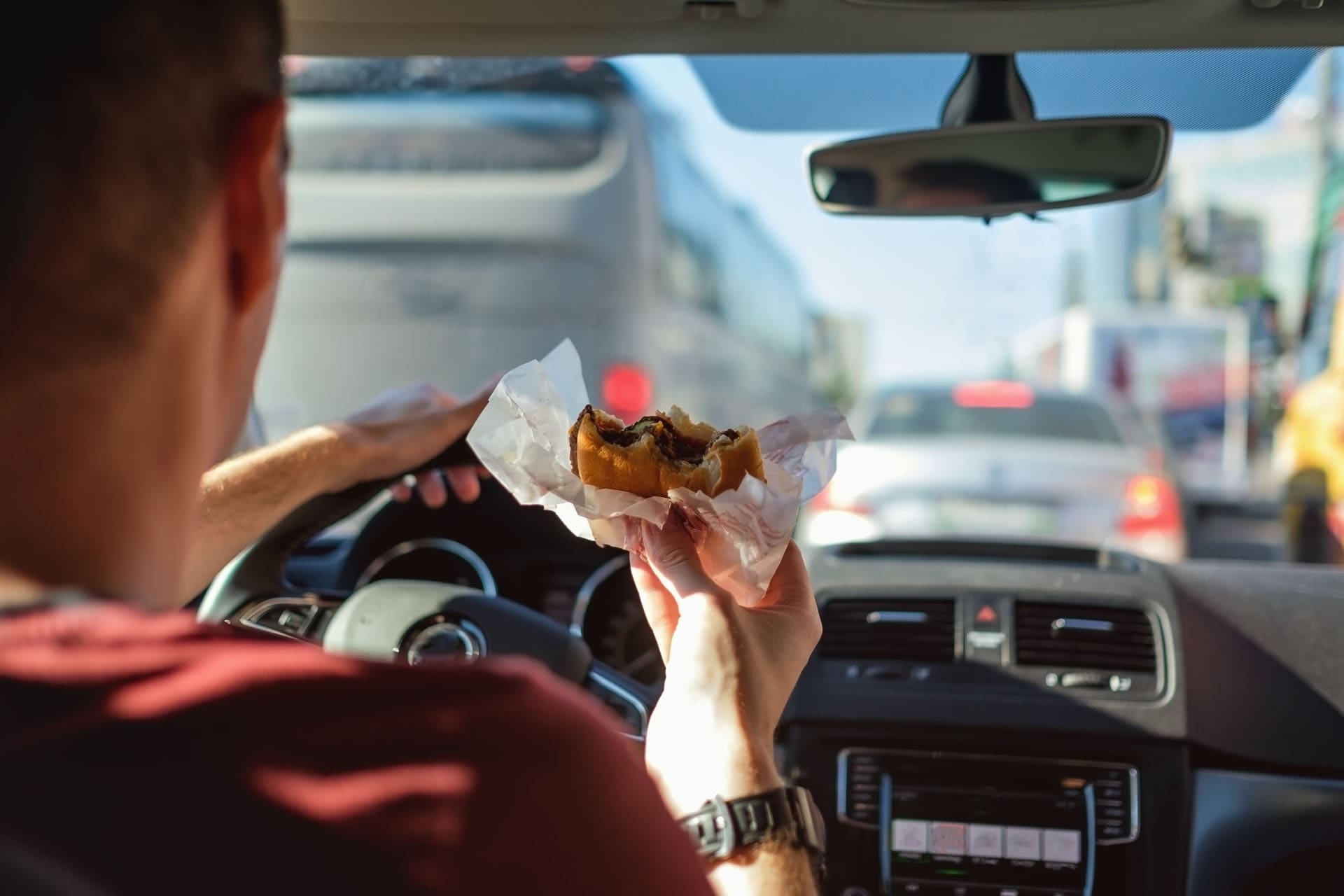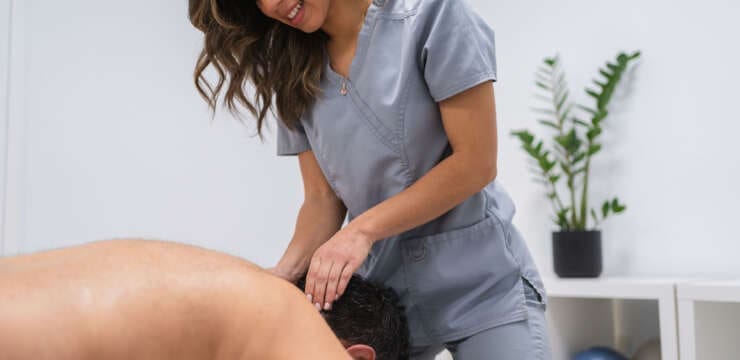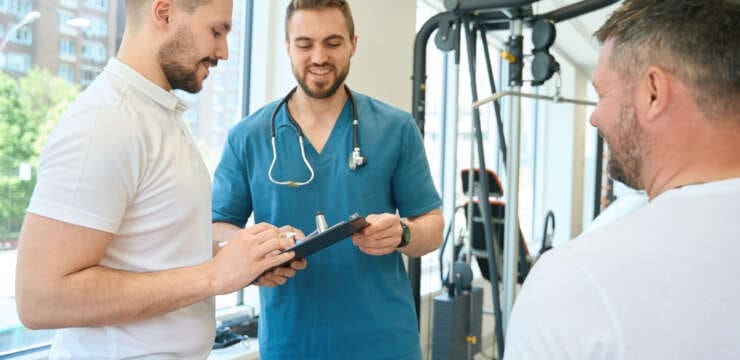
Table of Contents
Risks, Consequences, and Recovery Options

Driving is a daily activity that demands your full attention, yet many people multitask behind the wheel, often eating to save time. While grabbing a quick bite during a commute might seem harmless, certain foods can be particularly hazardous and lead to distracted driving. Eating while driving increases the risk of motor vehicle accidents (MVAs), which can cause severe injuries, financial burdens, and long-term health issues. Foods that require two hands, are messy, greasy, or hot, and are prone to spills, are especially dangerous, as they divert your eyes, hands, and focus from the road. This post explores the risks of eating while driving, the types of foods to avoid, the consequences of distracted driving, and how chiropractic care, nurse practitioners, and integrative medicine—particularly through the expertise of Dr. Alexander Jimenez in El Paso—can aid recovery from accident-related injuries.
Why Eating While Driving Is Dangerous
Eating while driving is a form of distracted driving, which the National Highway Traffic Safety Administration (NHTSA) defines as any activity that diverts attention from safe driving. Distracted driving includes visual, manual, and cognitive distractions, all of which occur when you eat behind the wheel. Visual distractions happen when you take your eyes off the road to look at your food or clean a spill. Manual distractions occur when you remove one or both hands from the steering wheel to hold food or a drink, thereby taking your attention away from the road. Cognitive distractions arise when your mind focuses on eating rather than driving, reducing your awareness of the road.
Studies show that eating while driving increases the likelihood of a crash by up to 80% (Farrin, n.d.). This is comparable to the risks of texting while driving, yet eating is often overlooked as a dangerous habit. The NHTSA also reports that 65% of near-miss accidents involve drivers distracted by food or drinks (Winters & Yonker, n.d.). These statistics underscore the significant risks associated with eating while driving, particularly with foods that are challenging to manage.
The consequences of distracted driving are severe. MVAs caused by eating can lead to musculoskeletal injuries like whiplash, nerve damage, chronic back and neck pain, and even fatalities. Beyond physical harm, accidents result in financial costs, including medical bills, vehicle repairs, fines, increased insurance premiums, and attorney fees. The safest choice is to eat before or after driving to keep your focus on the road.
References
Farrin. (n.d.). Eating while driving increases crash probability 80%. www.farrin.com/blog/eating-while-driving-increases-crash-probability-80/
Winters & Yonker. (n.d.). How common are car accidents due to eating while driving? www.wintersandyonker.com/blog/how-common-are-car-accidents-due-to-eating-while-driving/
The Most Dangerous Foods to Eat While Driving
Not all foods are equally hazardous when eaten behind the wheel. Foods that require two hands are often messy, greasy, or hot, and prone to spills, posing the greatest risks. Below is a detailed examination of the top foods to avoid, based on research and safety studies.
1. Coffee and Hot Beverages
Coffee is the most dangerous food item to consume while driving, despite being a liquid. Its high temperature can cause burns if spilled, leading to sudden reactions that take your attention off the road. Reaching for a cup, adjusting a lid, or cleaning a spill diverts your eyes and hands, which can increase crash risk. Many accidents involving coffee occur in the morning when drivers are rushed or concerned about their appearance for work (Reliable Plant, n.d.).
2. Tacos and Burritos
Tacos and burritos are notoriously messy, often requiring two hands to hold and eat. Their fillings—such as sauce, cheese, or vegetables—can spill easily, prompting drivers to look down or clean up, which can cause visual and manual distractions. The Zebra (n.d.) notes that these foods are among the most hazardous due to their tendency to create messes that demand immediate attention.
3. Burgers and Sandwiches
Burgers and sandwiches, especially those with condiments like ketchup or mayonnaise, tend to be greasy and prone to dripping. Unwrapping a burger or holding it with both hands takes your hands off the wheel, while greasy residue on your fingers can make the steering wheel slippery, reducing control (McCoy & Sparks, n.d.).
4. Fried Chicken
Fried chicken is greasy and often requires two hands to eat, especially if it’s bone-in. The slick coating can transfer to the steering wheel, and drivers may need to reach for napkins, which can further distract them. This food is particularly risky because it combines manual and visual distractions (McCoy & Sparks, n.d.).
5. Jelly or Cream-Filled Donuts
Jelly or cream-filled donuts are messy, with fillings that can ooze out when bitten. A spill on clothing or the car interior can prompt drivers to clean up immediately, taking their eyes off the road. Powdered sugar or glaze adds to the mess, making these a top distraction (Reliable Plant, n.d.).
6. Soft Drinks
Soft drinks, especially in large cups, can spill when drivers hit bumps or make sharp turns. Reaching for a drink, inserting a straw, or cleaning a spill causes manual and visual distractions. A bottle or can rolling under the driver’s seat is particularly dangerous, as it may tempt drivers to reach for it (Bailey Johnson, n.d.).
7. Chocolate
Chocolate melts easily, leaving sticky residue on hands and surfaces. Drivers may instinctively try to clean chocolate stains from their clothes or the steering wheel, diverting their attention. This food is risky due to its messiness and the cognitive distraction of dealing with stains (Reliable Plant, n.d.).
8. Soups and Hot Liquids
Soups and other hot liquids are hazardous due to their high temperature and potential for spills. A spill can cause burns, leading to panic and loss of vehicle control. These foods require careful handling, which is nearly impossible while driving (The Zebra, n.d.).
9. Ribs and Winged Foods
Ribs and chicken wings are greasy and saucy, often requiring two hands to eat. The mess they create—combined with the need for napkins—makes them highly distracting. Drivers may also need to look down to manage the food, increasing crash risk (McCoy & Sparks, n.d.).
10. Pizza
Pizza is greasy and often requires two hands to hold a slice. Melted cheese or toppings can slide off, prompting drivers to catch them or clean up, which takes their attention away from the road. Its messiness and handling requirements make it a risky choice (Auto Clinic Care, n.d.).
These foods share characteristics that make them hazardous: they demand extra attention, create messes, or require both hands, all of which contribute to distracted driving. Avoiding these foods while driving is critical to staying safe.
References
Auto Clinic Care. (n.d.). The most dangerous foods to eat while driving. www.autocliniccare.com/blog/the-most-dangerous-foods-to-eat-while-driving
Bailey Johnson. (n.d.). Eating while driving. baileyjohnson.com/blog/eating-while-driving/
McCoy & Sparks. (n.d.). Eating while driving: Is it dangerous? www.mccoyandsparks.com/blog/eating-while-driving-is-it-dangerous/
Reliable Plant. (n.d.). 10 most dangerous foods to eat while driving. www.reliableplant.com/Read/18890/10-most-dangerous-foods-to-eat-while-driving
The Zebra. (n.d.). Dangerous meals while driving. www.thezebra.com/resources/driving/dangerous-meals-while-driving/
How Eating While Driving Leads to Accidents
Eating while driving compromises your ability to react to sudden changes in traffic, increasing the likelihood of MVAs. Here’s how these distractions contribute to accidents:
Slower Reaction Times
When you’re eating, your brain is divided between driving your eating behavior and managing your food intake. This cognitive distraction slows your reaction time, making it harder to respond to hazards like a pedestrian crossing or a car braking suddenly. A study by the NHTSA found that eating while driving can significantly delay reaction times, contributing to crashes (Dont Get Hit Twice, n.d.).
Reduced Vehicle Control
Holding food or a drink with one hand—or both—reduces your grip on the steering wheel, limiting your ability to steer or brake effectively. Greasy foods can make the wheel slippery, further impairing control. This manual distraction is a key factor in accidents caused by eating (C&B Law Group, n.d.).
Visual Distractions
Looking at your food, unwrapping packaging, or cleaning a spill takes your eyes off the road, even for a few seconds. At 55 mph, a five-second glance covers the length of a football field, enough time to miss critical road changes (Farrin, n.d.). Visual distractions are particularly dangerous with messy foods like tacos or hot beverages.
Increased Risk for New Drivers
Newly licensed drivers are especially vulnerable to distractions from eating. The NHTSA reports that the crash risk for drivers while eating is three times higher than for experienced drivers, due to their limited ability to multitask (C&B Law Group, n.d.). This highlights the importance of all drivers, especially beginners, to refrain from eating behind the wheel.
These factors combine to make eating while driving a significant safety hazard, with consequences that extend beyond the immediate crash.
References
C&B Law Group. (n.d.). Ways eating food increases chances of car accident. cblawgroup.com/ways-eating-food-increases-chances-of-car-accident/
Dont Get Hit Twice. (n.d.). The dangers of driving while eating: How it can cause a wreck. www.dontgethittwice.com/blog/2025/march/the-dangers-of-driving-while-eating-how-it-can-c/
Farrin. (n.d.). Eating while driving increases crash probability 80%. www.farrin.com/blog/eating-while-driving-increases-crash-probability-80/
Consequences of Motor Vehicle Accidents
MVAs caused by distracted driving, including eating, have far-reaching consequences. These include physical injuries, financial burdens, and emotional trauma, all of which can disrupt your life.
Physical Injuries
MVAs often result in musculoskeletal and nerve injuries, such as:
- Whiplash: A common injury from rear-end collisions, causing neck pain, stiffness, headaches, and dizziness. Untreated whiplash can lead to chronic pain or degenerative disc disease (Jimenez, n.d.).
- Back and Neck Pain: Spinal misalignments or soft tissue damage can cause persistent pain, limiting mobility and affecting daily life.
- Nerve Damage: Injuries to nerves can result in numbness, tingling, or loss of function, requiring extensive treatment.
- Fractures and Soft Tissue Injuries: Broken bones or torn ligaments may require surgery or prolonged rehabilitation.
These injuries can take weeks or months to heal, and some may become chronic without proper care (Jimenez, n.d.).
Financial Costs
Accidents lead to significant expenses, including:
- Medical Bills: Costs for emergency care, imaging, therapy, or surgery can quickly add up.
- Vehicle Repairs: Damaged cars require costly repairs or replacement.
- Fines and Insurance Increases: Distracted driving violations may result in fines, and insurance companies may raise premiums or deny claims if eating contributed to the crash (Justice For You, n.d.).
- Attorney Fees: Personal injury claims often require legal representation, which adds to the expenses.
Emotional and Psychological Impact
The trauma of an MVA can cause anxiety, stress, or post-traumatic stress disorder (PTSD), especially if injuries are severe. Pain, financial strain, and legal battles can exacerbate these effects, impacting mental health and quality of life.
Avoiding distracted driving by eating before or after your trip can prevent these consequences, keeping you and others safe.
References
Jimenez, A. (n.d.). Car accident specialist in El Paso, TX. dralexjimenez.com/
Justice For You. (n.d.). Study reveals most dangerous food and drinks to eat while driving. www.justiceforyou.com/blog/study-reveals-most-dangerous-food-and-drinks-to-eat-while-driving/
Dr. Alexander Jimenez: Expertise in Auto Accident Recovery
Dr. Alexander Jimenez, DC, APRN, FNP-BC, is a leading chiropractor and nurse practitioner in El Paso, Texas, specializing in the treatment of MVA victims. With over 20 years of experience, Dr. Jimenez combines chiropractic care, integrative medicine, and advanced diagnostics to provide holistic, patient-centered recovery plans that promote comprehensive healing. His dual licensure as a Doctor of Chiropractic and a board-certified Family Nurse Practitioner allows him to address both medical and legal aspects of auto accident cases, making him uniquely qualified to treat complex injuries.
Clinical Rationale and Dual-Scope Diagnosis
Dr. Jimenez’s approach is grounded in the correlation between patient injuries and comprehensive diagnosis. MVAs often cause hidden injuries, such as soft tissue damage or spinal misalignments, that may not be immediately apparent due to adrenaline-masking symptoms (Jimenez, n.d.). His dual-scope expertise enables him to:
- Assess Medical and Chiropractic Needs: As a nurse practitioner, Dr. Jimenez evaluates overall health, including neurological and systemic issues. As a chiropractor, he focuses on spinal alignment, joint function, and musculoskeletal health.
- Use Advanced Diagnostics: He employs MRI, CT scans, electromyography (EMG), and functional movement screens to detect soft tissue damage, nerve injuries, and spinal issues. These tools provide objective evidence of injuries, crucial for treatment planning and legal documentation.
- Correlate Symptoms with Findings: By integrating imaging and clinical assessments, Dr. Jimenez ensures accurate diagnoses, addressing the root causes of pain and dysfunction rather than just symptoms.
This comprehensive approach enhances recovery by targeting both immediate and long-term health needs.
Distinctive Competencies
Dr. Jimenez’s qualifications set him apart in managing MVA cases:
- Dual Licensure: Licensed as a chiropractor in Texas and New Mexico and as a registered nurse in Texas with multistate privileges, he bridges conventional medical care and holistic chiropractic treatment.
- Integrative Medicine Expertise: His training in functional medicine, wellness nutrition, and detoxification protocols allows him to create personalized diet plans that reduce inflammation and support tissue repair, complementing physical therapies.
- Legal-Medical Integration: Dr. Jimenez is skilled in providing detailed medical reports and documentation for personal injury claims, ensuring patients receive fair compensation. His use of advanced diagnostics strengthens the credibility of injury reports for attorneys and insurance companies.
- Holistic Care Philosophy: He emphasizes non-invasive treatments, such as spinal adjustments, soft tissue therapy, and mobility training, to restore function without relying on drugs or surgery.
Role of Advanced Imaging and Diagnostics
Advanced imaging and diagnostic assessments are central to Dr. Jimenez’s practice. MRI and CT scans reveal soft tissue and spinal damage that may not appear in standard X-rays. EMG tests assess nerve function, identifying issues like pinched nerves or neuropathy. Functional movement screens evaluate mobility and posture, guiding rehabilitation plans. These tools not only inform treatment but also provide objective evidence for legal cases, validating patient injuries and supporting claims (Jimenez, n.d.).
References
Jimenez, A. (n.d.). Car accident specialist in El Paso, TX. dralexjimenez.com/
Jimenez, A. (n.d.). LinkedIn profile. www.linkedin.com/in/dralexjimenez/
Chiropractic Care and Integrative Medicine for Recovery
Chiropractic care and integrative medicine offer holistic, effective solutions for recovering from MVA injuries. These approaches focus on addressing the underlying causes of pain and dysfunction, promoting overall health without invasive procedures or medications.
Benefits of Chiropractic Care
Chiropractic care is ideal for MVA victims because it:
- Relieves Pain Naturally: Spinal adjustments and soft tissue therapy help alleviate pain associated with whiplash, back injuries, and joint misalignments, without the need for medication, thereby minimizing side effects (Cleveland Clinic, n.d.).
- Restores Mobility: Adjustments correct spinal misalignments, improving range of motion and reducing stiffness.
- Prevents Chronic Pain: Early intervention prevents minor injuries from becoming long-term issues, such as degenerative disc disease.
- Supports Nervous System Health: Maintaining proper spinal alignment enhances nerve function, promoting overall recovery.
Chiropractors, such as Dr. Jimenez, also recommend exercises, stretches, and ergonomic adjustments to support healing at home.
Integrative Medicine Approach
Integrative medicine combines conventional and holistic therapies to optimize health. For MVA recovery, it includes:
- Nutrition and Diet Plans: Anti-inflammatory diets rich in fruits, vegetables, and lean proteins reduce swelling and promote tissue repair. Dr. Jimenez designs patient-specific plans to support healing (Jimenez, n.d.).
- Functional Medicine: This approach addresses underlying health issues, such as stress or chronic inflammation, that may slow recovery.
- Wellness Therapies: Detoxification protocols and stress management techniques enhance mental and physical resilience.
Role of Nurse Practitioners
Nurse practitioners like Dr. Jimenez play a critical role in integrative care by:
- Coordinating Treatment: They oversee medical and chiropractic care to ensure a cohesive recovery plan.
- Providing Comprehensive Assessments: Their medical training allows them to evaluate systemic health issues that may impact healing.
- Educating Patients: They guide patients on lifestyle changes, such as diet and exercise, to support long-term health.
Together, chiropractic care and integrative medicine address the physical, emotional, and legal challenges of MVA recovery, helping patients regain their quality of life.
References
Cleveland Clinic. (n.d.). Chiropractic adjustment care, treatment & benefits. my.clevelandclinic.org/health/treatments/21033-chiropractic-adjustment
Jimenez, A. (n.d.). Health coach clinic. healthcoach.clinic/
Tips to Avoid Eating While Driving
Preventing distracted driving starts with planning and awareness. Here are practical tips to avoid eating behind the wheel:
- Eat Before or After Driving: Schedule meals or snacks before you leave or upon arrival to maintain your focus on the road.
- Plan Breaks on Long Trips: Use rest areas or restaurants to eat safely during road trips.
- Keep Food Out of Reach: Store snacks in the trunk or backseat to reduce temptation.
- Choose Easy-to-Handle Drinks: If you must drink, use slim containers with one-hand lids to minimize distractions.
- Educate New Drivers: Teach teens and inexperienced drivers the dangers of eating while driving to build safe habits early.
- Clean Your Car Regularly: Remove trash or loose items that could roll under pedals and cause distractions.
By following these tips, you can reduce the risk of accidents and stay safe on the road.
References
Justice For You. (n.d.). Study reveals most dangerous food and drinks to eat while driving. www.justiceforyou.com/blog/study-reveals-most-dangerous-food-and-drinks-to-eat-while-driving/
Conclusion
Eating while driving is a dangerous form of distracted driving that significantly increases the risk of motor vehicle accidents. Foods that require two hands, such as those that are messy, greasy, or hot and prone to spills—like coffee, tacos, burgers, and donuts—are particularly hazardous, as they cause visual, manual, and cognitive distractions. The consequences of MVAs, including musculoskeletal injuries, chronic pain, financial burdens, and emotional trauma, highlight the importance of eating before or after driving. For those injured in accidents, chiropractic care and integrative medicine, led by experts like Dr. Alexander Jimenez in El Paso, offer holistic recovery options. Dr. Jimenez’s dual expertise as a chiropractor and nurse practitioner, combined with advanced diagnostics, ensures comprehensive treatment and legal support for MVA victims. By avoiding dangerous foods and seeking proper care after accidents, you can protect your safety and health.
References
Auto Clinic Care. (n.d.). The most dangerous foods to eat while driving. www.autocliniccare.com/blog/the-most-dangerous-foods-to-eat-while-driving
Bailey Johnson. (n.d.). Eating while driving. baileyjohnson.com/blog/eating-while-driving/
C&B Law Group. (n.d.). Ways eating food increases chances of car accident. cblawgroup.com/ways-eating-food-increases-chances-of-car-accident/
Cleveland Clinic. (n.d.). Chiropractic adjustment care, treatment & benefits. my.clevelandclinic.org/health/treatments/21033-chiropractic-adjustment
Dont Get Hit Twice. (n.d.). The dangers of driving while eating: How it can cause a wreck. www.dontgethittwice.com/blog/2025/march/the-dangers-of-driving-while-eating-how-it-can-c/
Farrin. (n.d.). Eating while driving increases crash probability 80%. www.farrin.com/blog/eating-while-driving-increases-crash-probability-80/
Jimenez, A. (n.d.). Car accident specialist in El Paso, TX. dralexjimenez.com/
Jimenez, A. (n.d.). Health coach clinic. healthcoach.clinic/
Jimenez, A. (n.d.). LinkedIn profile. www.linkedin.com/in/dralexjimenez/
Justice For You. (n.d.). Study reveals most dangerous food and drinks to eat while driving. www.justiceforyou.com/blog/study-reveals-most-dangerous-food-and-drinks-to-eat-while-driving/
McCoy & Sparks. (n.d.). Eating while driving: Is it dangerous? www.mccoyandsparks.com/blog/eating-while-driving-is-it-dangerous/
Reliable Plant. (n.d.). 10 most dangerous foods to eat while driving. www.reliableplant.com/Read/18890/10-most-dangerous-foods-to-eat-while-driving
The Zebra. (n.d.). Dangerous meals while driving. www.thezebra.com/resources/driving/dangerous-meals-while-driving/
Winters & Yonker. (n.d.). How common are car accidents due to eating while driving? www.wintersandyonker.com/blog/how-common-are-car-accidents-due-to-eating-while-driving/
Disclaimers
Professional Scope of Practice *
The information herein on "The Dangers of Eating While Driving" is not intended to replace a one-on-one relationship with a qualified health care professional or licensed physician and is not medical advice. We encourage you to make healthcare decisions based on your research and partnership with a qualified healthcare professional.
Blog Information & Scope Discussions
Welcome to El Paso's wellness blog, where Dr. Alex Jimenez, DC, FNP-C, a board-certified Family Practice Nurse Practitioner (FNP-C) and Chiropractor (DC), presents insights on how our team is dedicated to holistic healing and personalized care. Our practice aligns with evidence-based treatment protocols inspired by integrative medicine principles, similar to those found on dralexjimenez.com, focusing on restoring health naturally for patients of all ages.
Our areas of chiropractic practice include Wellness & Nutrition, Chronic Pain, Personal Injury, Auto Accident Care, Work Injuries, Back Injury, Low Back Pain, Neck Pain, Migraine Headaches, Sports Injuries, Severe Sciatica, Scoliosis, Complex Herniated Discs, Fibromyalgia, Chronic Pain, Complex Injuries, Stress Management, Functional Medicine Treatments, and in-scope care protocols.
Our information scope is limited to chiropractic, musculoskeletal, physical medicine, wellness, contributing etiological viscerosomatic disturbances within clinical presentations, associated somato-visceral reflex clinical dynamics, subluxation complexes, sensitive health issues, and functional medicine articles, topics, and discussions.
We provide and present clinical collaboration with specialists from various disciplines. Each specialist is governed by their professional scope of practice and their jurisdiction of licensure. We use functional health & wellness protocols to treat and support care for the injuries or disorders of the musculoskeletal system.
Our videos, posts, topics, subjects, and insights cover clinical matters, issues, and topics that relate to and directly or indirectly support our clinical scope of practice.*
Our office has reasonably attempted to provide supportive citations and has identified the relevant research studies or studies supporting our posts. We provide copies of supporting research studies available to regulatory boards and the public upon request.
We understand that we cover matters that require an additional explanation of how they may assist in a particular care plan or treatment protocol; therefore, to discuss the subject matter above further, please feel free to ask Dr. Alex Jimenez, DC, APRN, FNP-BC, or contact us at 915-850-0900.
We are here to help you and your family.
Blessings
Dr. Alex Jimenez DC, MSACP, APRN, FNP-BC*, CCST, IFMCP, CFMP, ATN
email: coach@elpasofunctionalmedicine.com
Licensed as a Doctor of Chiropractic (DC) in Texas & New Mexico*
Texas DC License # TX5807
New Mexico DC License # NM-DC2182
Licensed as a Registered Nurse (RN*) in Texas & Multistate
Texas RN License # 1191402
ANCC FNP-BC: Board Certified Nurse Practitioner*
Compact Status: Multi-State License: Authorized to Practice in 40 States*
Graduate with Honors: ICHS: MSN-FNP (Family Nurse Practitioner Program)
Degree Granted. Master's in Family Practice MSN Diploma (Cum Laude)
Dr. Alex Jimenez, DC, APRN, FNP-BC*, CFMP, IFMCP, ATN, CCST
My Digital Business Card






